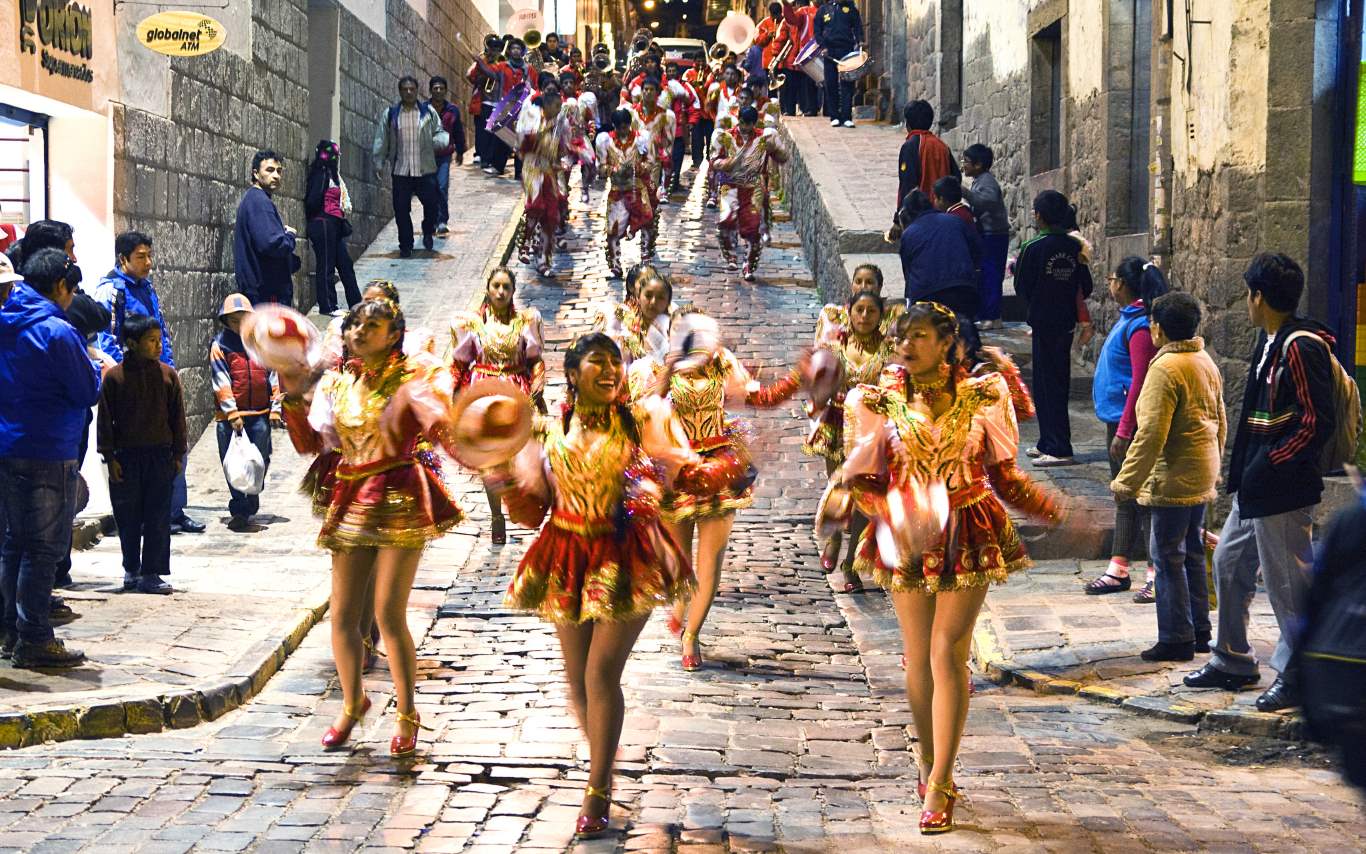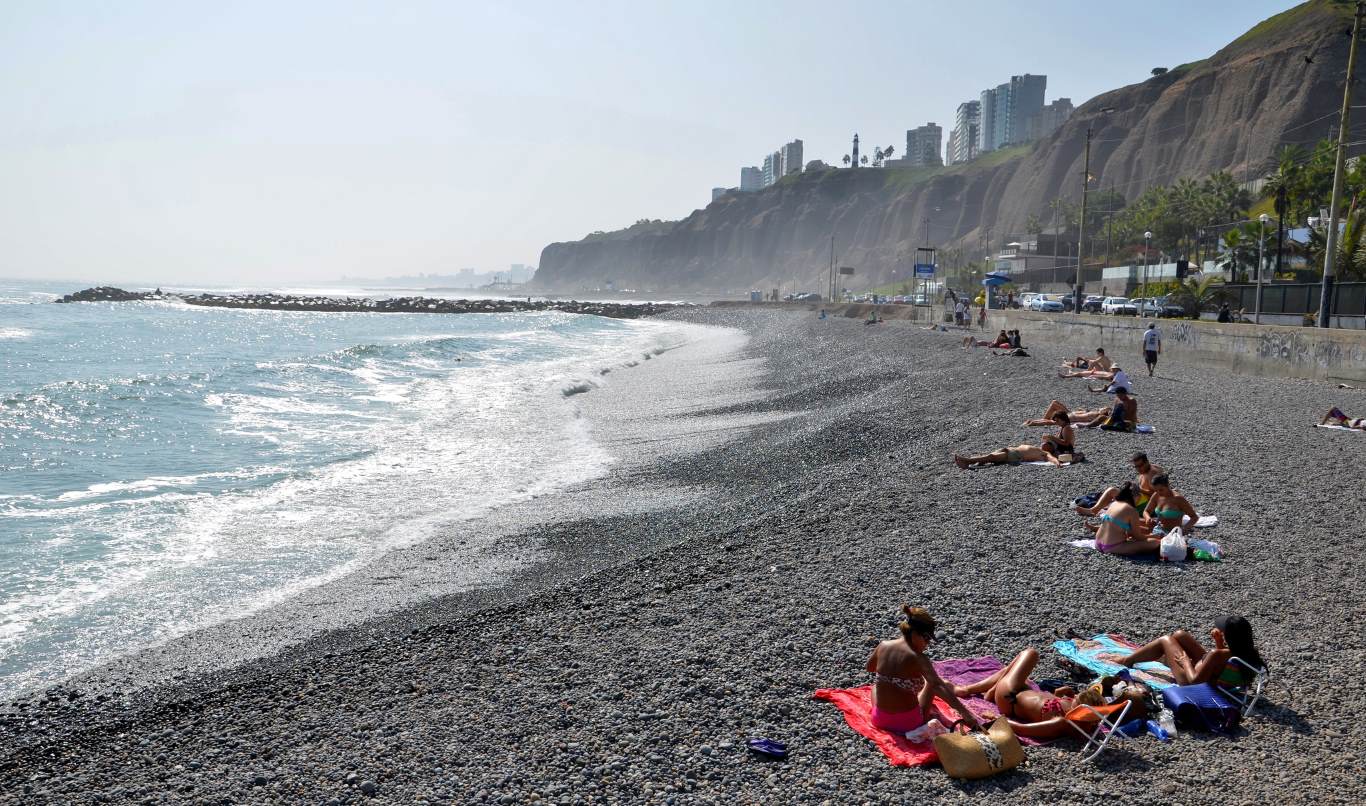The day-to-day dress code in Peru can be as somber or as colorful as you like. Photo by Dimitry B., flickr.com.
You’ve packed your bags for Peru. You’ve got all the clothes you need for walking the streets of Lima and trekking to Machu Picchu. And then you somehow find yourself invited to a wedding. Or to a fancy restaurant. Or, god forbid, to some formal event where you might actually have to wear a tie.
So now you’re wondering if there’s a specific dress code in Peru. How should you dress? What should you wear? And can you wear sandals to a quinceañera….?
The Day-to-Day Dress Code in Peru
What you wear on a day-to-day basis in Peru is entirely up to you. There’s no real etiquette when it comes to clothing in Peru, and no strict religious or social taboos to bear in mind. But people will judge you to a certain extent depending on what you’re wearing, as they do across the globe.
The majority of Peruvians are fairly conformist when it comes to clothing, and they certainly notice — and occasionally comment on — the occasionally outlandish clothing of foreigners.
Some locals are also quite judgmental. For example, many Peruvians think that hippies are unwashed vagabonds who need a good scrub in a hot bath.
On the flipside, if you’re a sharp dresser — golden wristwatch, Armani shirt, Gucci leggings (?) — you’ll attract an altogether different type of attention. Amorous advances will probably be more frequent, but not always well intentioned. You’ll also be a far more tempting target for all the nearby muggers.
Foreign women wearing revealing clothing will almost certainly find themselves subject to street harassment by Peruvian men, even if the men don’t consider it as such. But don’t let that change the way you choose to dress.
Restaurants
It’s rare for a restaurant in Peru to have a formal dress code. Feel free to dress up if you like — especially if it’s a more formal dinner gathering — but you rarely have to worry about being let in to a restaurant because of what you’re wearing.
I contacted three popular upscale restaurants in Lima to see if they have any kind of dress code. Their responses:
- Central Restaurant: no dress code
- Astrid y Gaston: no dress code (“the attire is casual”)
- Maido: no dress code
Nightlife
Peruvians like to dress up when they go out drinking and dancing. Even in the heat of the jungle, most men will head out to bars and discotecas wearing trousers rather than the more typical daytime shorts. Some of them also wear long-sleeved shirts. I live in the jungle and I never go out at night in trousers — it’s too damn hot. But no one cares.
As far as I know, I’ve never been to a club in Lima or Arequipa or Cusco or anywhere else in Peru that has a dress code. But I guess some of the more exclusive (uptight) nightclubs might have a no-shorts policy. If you’re going somewhere super-swanky, then it might be worth checking in advance.
Beaches
You’ll be fine on Peru’s beaches whatever you wear, as long as you don’t go topless (or bottomless). If you wear one of those tiny Brazilian fio dental (dental floss) bikinis like you see on the beaches of Rio, then expect a few stares. And probably some comments. But no one will ask you to leave the beach.
If you really want to let it all hang out, then head to Puerto Bonito about 45 miles south of Lima. As far as I know, it’s the only nudist beach in Peru.
Sunbathing in Lima. Going topless is normally prohibited. Photo by Christian Córdova, flickr.com.
Business Dress in Peru
Business dress in Peru is the same as the traditional Western dress code: men wear suits (or at least a shirt and trousers) and women wear dresses, skirts or blouses (or a variant of the suit, but that’s less common in Peru).
Indigenous Peruvians might have their own traditional dress for formal occasions, including for business.
Hospitals
I was once denied entry to a hospital in Tarapoto because I was wearing shorts (I was trying to visit a friend who was about to give birth). I’m not sure how common this is in Peru, or if it’s standard policy in other hospitals around the world, but bear it in mind if you want to visit someone.
Dealing with State Officials and Peruvian Bureaucracy
While you can normally enter government buildings wearing whatever you like (within reason), it’s worth dressing up a little if you’re trying to get something done quickly and without additional fuss.
For example, a border official might treat you better if you look respectable (by his standards), rather than scruffy and disheveled. And that could make the difference between being given 183 days in Peru (on your Tarjeta Andina), or just 90.
As a general rule, if you know you’ll be dealing with any kind of Peruvian bureaucracy or officialdom, dress slightly smarter than usual. It all helps.
As a side note, the US Embassy in Peru does not have a dress code. They do recommend wearing “adequate and comfortable” clothing.
In Schools, Colleges and Universities
Business casual/smart casual is normally fine if you’re visiting or teaching at a school, college or university in Peru. Excessive tattoos and piercings might well be frowned upon in some institutions.
In Churches and Cathedrals
Foreign tourists frequently wander into churches and cathedrals in Peru wearing shorts, sandals and a T-shirt, with a camera strapped around their necks. That doesn’t seem to be a problem. But taking photos (especially with a flash) and talking loudly is a problem and should be avoided.
Family Celebrations and Events
Birthday parties, graduation festivities, quinceañeras and other such events don’t have any kind of dress etiquette for guests. That said, Peruvians will often dress up for these parties — the women more so than the men. As a foreign visitor, no one will mind if you turn up in your shorts, jeans, flares or whatever.
Peru Dress Code for Funerals and Weddings
It’s always tricky if you unexpectedly need to attend a wedding or a funeral while you’re traveling. And it’s highly unlikely that you’ll have packed anything appropriate for such an occasion.
For a wedding, just try to dress as smartly as possible. The dress code for Peruvian weddings is similar to a regular (i.e. not too extravagant or upper-class) wedding in the USA or the UK. If the invitation specifies smart or formal clothing, then you’ll have to try to borrow or rent something. Suit rentals are normally possible in Peru’s major cities.
Funerals are obviously a serious and somber affair, making the dress etiquette a more pressing issue. Peruvian funerals have two elements: the funeral itself and the velorio (vigil). If you need to attend a funeral service, then you should try to wear primarily black (unless you hear otherwise). A suit is ideal for a man, which you can try to rent or perhaps borrow from a friend. Otherwise, just dress as smartly as possible, ideally in a shirt, trousers and shoes. Avoid shorts, T-shirts and sandals. Women typically wear black or other dark or muted colors.
The velorio, which normally takes place outside the deceased’s family home, is less formal. But you should still try to dress in a reasonably formal manner.
A lavish church wedding in Peru. You might want to hire a suit for this one… Photo by Bruce Dailey, flickr.com.








I’m a guy that normally wears circular barbell earrings (one each ear). Would something like that cause issues, or should I just not wear them? Thanks!
Hi Shaun. That won’t be a problem at all if you’re just traveling around Peru. Might only be an issue if you wanted to get a job here (depending on the type of job), but otherwise go ahead and wear them. Cheers, Tony.
Hi, my parents are from Peru, so I grew up around there on the border. Men wearing earring sure got a lot of attention.
Hi Tony, I am a Venezuelan one and I am traveling to Peru next 28, is there any thing I need to know about customer officers at airport? How strict are they? I am going to stay about 3 months, although my tickets is for 1 month. If I found a job I will stay there, other wise I will move out to USA. I still ok to say to the customer offices my intentions?
Thanks in advance.
Hi Jose. As long as you have the necessary paperwork, you shouldn’t have any problems with customs at the airport. Unless the immigration officer asks you specifically about your plans, it’s best just to not say anything. But if he does, it might be best to explain your situation. That said, if he sees that your ticket is only for one month in Peru, he might only give you one month on your visa. But that depends on what type of visa you have and the current situation for Venezuelans entering Peru, which I’m not 100% sure about. Let me know if you have any other questions. Thanks, Tony.
Peruvians LIKE to look smart. My master builder arrived in smart shirt trousers & shoes, changed into scruffy for building work and at the end of the day washed and left in his nice clothes.
As a foreigner you are highly visible. You won’t feel a thing. I can see foreign visitors round 2 street corners!
Peruvians don’t necessarily make judgements. What I hear is they are pleased that someone has taken the trouble making such a long journey to see our country – nevertheless it’s a compliment not to let “foreigners” down by being too tatty. SHOES are a big item. Take advantage of shoeshine men.
It’s also welcome to show grace in your manners, in introductions (Buenos Dias), questions (Por Favor), acknowledgements (Gracias, Muchas Gracias), and goodbye (Permiso, Chau). Permiso is a great word dealing with crowds, but quietly please. Noisy and Tense upsets eveyone.
Slightly off topic but I think relevant nontheless, HTH.
hi, i’m going to peru on a school field trip. i leave in 4 days. i was wondering if i should have any concerns on what to wear because i’ve heard that women sometimes run into trouble. i’m 5’8 and i’m blonde with blue eyes. is peru dangerous, should i cover up more than i do at home? idk maybe everyones making me paranoid.
thanks!
Hi Alex. There’s no need to be paranoid, but you should be prepared for some whistling and some dumb comments from Peruvian guys. It’s normally not meant as aggressive, although I’m sure it can feel that way. As for what to wear, you don’t need to cover up, especially in Lima, but you’ll obviously get more attention if you’re dressed in a more revealing way. And blondes do normally get more attention here. But yeah, don’t worry about it, stick with your friends, and you’ll be fine. Just ignore any dumb comments, or deal with them however you like. Have fun, and let me know if you have any more questions. Tony.
Hey Tony thanks for the info, I will be coming to Lima in july for dental work. Anything I need to know?
Hi Max. Anything you need to know about dental work? No idea to be honest. Should be a fairly normal procedure (like back home) as far as I know. Beyond that, I can’t think of anything you need to know about. Cheers, Tony.